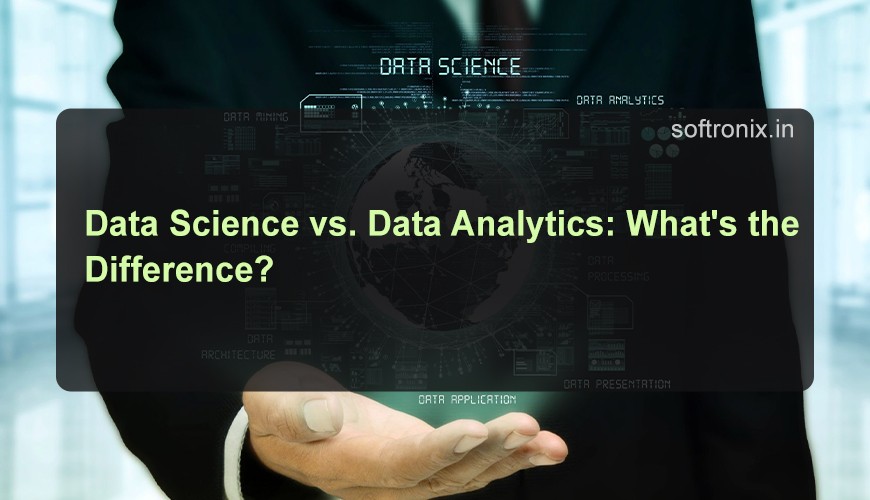
Data Science vs. Data Analytics: What's the Difference?
In the world of data science, Data Science and Data Analytics can mean the same thing or two different things in the same data field. Although both aim at the data analysis process, their objectives, processes, and professional demands are hugely dissimilar. To conclude, Data Science is more focused on erecting systems, models, and algorithms in a position to reach decisions or predict trends on their own using techniques such as machine learning and artificial intelligence. In contrast, Data Analytics majorly deals with analyzing data that has accrued in the past, to respond to certain business inquiries, establish patterns, and supply valuable insights that help organizations make decisions.
To utilize the data effectively, businesses need to know the baseline of these two disciplines. Often it is frustrating for individuals who are intending to make a career shift to decide whether to lean towards Data Science or Data Analytics. In this blog post, let us identify the main difference between Data Science and Data Analytics to understand what each job entails and which profile suits you best.
In today’s post, we’ll explain what separates data science from data analytics, as well as where and how the two disciplines intersect and collaborate in today’s commercial environment.
1. Defining Data Science
Data Science is an interdisciplinary subject that uses tools of Mathematics, Computer Science, and domain insights to manage and understand data. The primary idea that lies in data science is to identify relationships, develop models, and distill algorithms on which decisions can be based in the future.
Key characteristics of Data Science:
Exploratory: There is no need for a predictive model or even hypothesis; data scientists begin their work by describing the raw data inputs.
Predictive Models: Machine learning and artificial intelligence involve getting data scientists to design models for creating predictions or executing functions.
Big Data: Currently, big data and data science work with numerous amounts of ambiguous data from sources like social media, sensors, and customers’ logs.
Tools and Technologies: Tools that are common in the data science profession are programming languages such as Python, R, and SQL, and tools such as Hadoop, TensorFlow, and Apache Spark.
Key Focus Areas in Data Science:
Predictive Analytics: Making predictions or probable estimations for a future situation or event by analyzing past events.
Machine Learning (ML): Designing machines and programs that self-input from a given data and make decisions or, at the very least, make predictions.
Artificial Intelligence (AI): Ironically, it includes creating systems that are capable of doing those tasks that were presumed to be well within the ability of the human brain on its own, like natural language processing or computer vision.
Data Engineering: Creating structures to handle the big data that is abundant in all fields to make it easy to organize, standardize, store, and process data.
2. Defining Data Analytics
Data analytics is simply the examination of data for the purpose of extracting valuable information and making decisions from it. Whereas Data Science is about developing models as well as algorithms to know what to expect in the future Data Analytics is more about trawling through the data to find out what has been happening in the past to answer certain business queries.
Key characteristics of Data Analytics:
Descriptive and Diagnostic: Data analysts usually follow the evaluation of previous outcomes and aim at providing answers to certain questions such as ‘why’ a given occurrence occurred ‘or’ what ‘is the state’ of a given affair at the current time.
Structured Data: Data analysis usually concerns itself with tabular data or data in tables like a database or Excel rather than the raw, unformatted, or even semi-formatted data used in data science.
Actionable Insights: The primary use of data analytics is to explain findings that can be used by the business in decision-making.
Tools and Technologies: These technologies include Excel, Tableau, Power BI, and SQL, and the data analyst may have prior working knowledge of statistical programming languages such as R or Python
Key Focus Areas in Data Analytics:
Descriptive Analytics: Summarizing by analyzing the previous events, such as the sales statistics, customer interaction patterns, etc.
Diagnostic Analytics: Business intelligence, is a process of analyzing the deeper reasons why something occurred, often in relation to lowering sales performance or high customer attrition.
Prescriptive Analytics: Providing suggestions on the steps that should be taken following the data processing, such as; recommendations of what should be done with regards to inventory or even recommendations on best strategies to be used in marketing.
Data Visualization: This looks at offering the results in a way that is more understandable to decision-makers through the use of charts, graphs, and even dashboards.
3. Key Differences Between Data Science and Data Analytics
Data Science and Data Analytics are two sides of the same data-driven approach within an organization helping deliver strategic-level insights. Machine Learning on the other hand focuses on constructing models on how systems will decide in order to solve a certain problem or predict the occurrence of an event. It frequently analyzes extents and varieties and uses such things as machine learning, artificial intelligence, and statistical modeling. The tasks of data scientists involve coding in program languages like Python and R and using data analysis tools like TensorFlow, Hadoop, Spark, etc. Just like detectives, their work is analytical and integrated into identifying such structures in databases that are normally not discernible, and their objective is usually to design machines for making forecasts or for performing certain operations.
Data Analytics is slightly more defined as it is used to understand past data to answer some questions for the business or organization and come up with plausible conclusions. It is common for data analysts to operate on columns of numbers, rows of tables, or data fields, to gain insights on what has occurred and the reasons for it. They use Excel, SQL, Tableau, and power BI for analysis, presentation of data results, and information that can be used to help businesses make decisions. While data scientists employ sophisticated algorithms to make forecasts for future conditions, data analysts concern themselves mainly with how to interpret them to identify trends, diagnose problems, and provide recommendations for their timely action.
Finally, Data Science is more futuristic and concerned with predictive modeling and the use of automation while Data Analytics is more backward-looking and concentrates on using data to understand the present to enhance current outcomes or strategies. While coming from similar backgrounds, data scientists usually need more programming background, algorithms, and machine learning, while data analysts usually are more focused on data interpretation, data visualization, and business intelligence.
4. The Overlap: Where Data Science and Data Analytics Meet
While Data Science and Data Analytics are distinct fields, they complement each other in many ways:
Data Analysis is normally a subprocess of the work done by data scientists. For instance, data analysts as a part of the data modeling process, algorithm tuning, and selection of important data features employ data analytics.
In some organizations, data scientists may also be involved in data analytics if, for example, they are reporting on the outcome of their machines’ prediction or helping the clients understand the results.
The two disciplines heavily depend on proper and efficient ways of representing conclusions and outcomes. In every case of a dashboard provided to stakeholders – be it data analysts – or the presentation of the results of a predictive model to data scientists, such interpretation remains critical.
5. Which One Should You Choose?
So, if topics like predictive modeling, machine learning, and building algorithms then data science is more appropriate for you. However, the training of such an analyst entails having adequate knowledge of programming, especially statistical programming and advanced mathematics.
If you find it more comfortable to operate with data to answer a particular business concern, offer significance, and generate dashboards, then data analytics could be more appropriate. Data analytics involves analytical thinking, a knowledge of business processes, data presentation, and probability.
6. Which one is best to use?
The best option depends on who your audience is going to be, and the type of look that you want to achieve. Here's a quick comparison to help you decide:
1. First Version (More Formal and Structured):
Pros: By being slightly more formal, it should work best for a professional or technical audienceactical audience. The texts delineate distinctive actions, and therefore, readers will not have difficulties understanding who does what to whom.
Use This If: If you are writing for your target audience that includes professional individuals, industry gurus, or those who would like to see concepts being explained in a concise, simple, but segregated manner.
2. Second Version (More Conversational and Engaging):
Pros: This version is a little more casual and reads rather more fluently. It may be less complicated and would appeal more to practitioners or those who have little to no experience in the profession.
Use This If: You would like your work to find the widest possible readership-intermediate students, working practitioners, and even those who work in unrelated fields but occasionally face problems that could be solved with appropriate data science methods. It is also relevant for Internet sites containing blogs for ordinary learners or those Internet sites for learners intending to choose a precise occupation.
Why Softronix?
An understanding of the various factors of the tech industry put Softronix in a strategic position to be a leading player and this has been enhanced by the company’s ability to innovate, quality work, and deliver customer satisfaction. Being a software solutions provider company, it has carved out a niche for itself focusing on improving the internal dynamics of organizations to offer flexible and effective solutions. Whether you need software development, help consulting, or enterprise solutions, this company can offer a deep understanding of client’s requirements and their implementation.
the expert staff, modern technologies and focus on client needs as the key to providing effective Softronix solutions. Softronix has succeeded in being adaptive to the industry requirements, and remaining an important focus on the user requirements; that is how the company has gained the confidence of the businesses and has become their guide in the world of competitiveness in the digital environment.
Conclusion
Data Science and Data Analytics, both, are related professions that deal with data, but the methods that they use and the goals they have are different. Data Science is more strategic with certain elements such as machine learning and artificial intelligence to forecast future events, whereas Data Analytics is primarily the interpretation of past data to drive future business actions. Two fields are immensely important in today’s innovative business environment, and each of them contributes to turning organizations into competitive advantages.
Now that we’ve outlined what data science and data analytics are and how they differ, you can make better decisions about working for a company that needs data professionals or choosing between different occupations. For further details visit Softronix today!

0 comments